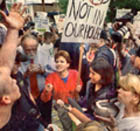By Pat Ford
Pew Center
“Men and women of the white race, now is the time to show just how white and proud you really are. We all fight for the survival of our white heritage, the purity of our white families. We must come together now to become a proud white force”…
The flyers for a white supremacist Fourth of July rally that started going up around Enumclaw, last June, shocked residents and drew regional media to the town, about 30 miles east of Tacoma.
Reporters parachuted in from nearby cities and bureaus to tell the dismaying story of overt racism turning up so close by. Then they left and put the rally on their daybooks for the Fourth.
 For News Tribune reporter Aimee Green, though, it was the beginning of a careful exploration of the town, its response to the flyers, and of the individuals who planned the rally. Green’s story gave depth and context to an event that could easily have become distorted and sensationalized by traditional coverage. Where readers might have been left with superficial images and inaccurate impressions of Enumclaw and its residents, Green provided a view of ordinary people struggling with issues larger than themselves.
For News Tribune reporter Aimee Green, though, it was the beginning of a careful exploration of the town, its response to the flyers, and of the individuals who planned the rally. Green’s story gave depth and context to an event that could easily have become distorted and sensationalized by traditional coverage. Where readers might have been left with superficial images and inaccurate impressions of Enumclaw and its residents, Green provided a view of ordinary people struggling with issues larger than themselves.
“We wanted to let people know what it was all about,” says Green. “It’s easy to make assumptions but it’s more interesting to get beneath the surface and see the truth of what’s going on.”
Coincidentally, Green was in the midst of three-part seminar on “civic mapping” at the Harwood Institute in Boulder. The seminars, supported with funding from the Pew Center, teach reporters and editors to cover communities by penetrating beneath layers of official sources to find informal leaders. Green says she realized the techniques she was learning could be invaluable in Enumclaw.
“It helped me plan out (my reporting),” she says. “It gave me kind of a checklist to make sure I was getting the most accurate picture. I would check it over and say ‘Did I really talk to everyone?’ “
Green says she spent a lot of time going to “third places,” spots in a community where people gather informally and end up discussing community concerns. Barber shops, for instance. But in visiting Dick’s Barber Shop in Enumclaw, Green found the barber who was shaving the heads of some of the rally organizers.
Green says the seminars also taught her a new way to report, not strictly by interviewing but also by listening to people talk to each other. “A labor group went around and passed out stickers that said ‘Hate-Free Zone’ to local businesses and I just listened to what they said and what people said back,” says Green.
Reporting her way through retail shops, restaurants, the library, the youth center, the parking lot next to the local high school, Green eventually learned exactly who had planned the rally and arranged to meet them. “No other paper, not even the local paper, had their names,” she says.
Green admits to being a little apprehensive about meeting the organizers. “My background is I’m part Korean and part white and their flyer said specifically they were against mixing races,” says Green. “But it told me more that they were willing to talk to me and didn’t seem to hate me. They were very polite and somewhat open.”
Green soon found herself in the middle of a family fight between an 18-year-old organizer and his mother, who strongly opposed the rally and insisted The News Tribune withhold his identity. Green decided to make the fight part of her story:
All day Friday, his mother begged The News Tribune not to print her son’s name. She told the Enumclaw High School senior that she’d throw him out if the family’s name was in the paper… So the newspaper decided to use only her son’s first name, Andy… After much heated debate with his mother, Andy said Friday evening that he won’t attend (the Fourth of July rally.)
“By bringing out his struggle with his mother,” says Green, “we showed how young these kids are and how they’re struggling with this issue.”
News Tribune executive editor Dave Zeeck says he got a call after the story ran from a Hispanic reader who felt the story got so close to the organizers that the paper was glorifying their position. “He was very upset and I think it was the resonance of reality that he saw that struck a nerve,” says Zeeck.
Zeeck praises the story as having a “greater level of authenticity” because of the way it was reported. “It’s like that parlor game where you pass a secret down the lane and it gets distorted by the end of the circle,” he says. “Talking to sources even two levels removed, you don’t get the truer story that you get with real people. There’s a heightened sense of reality when you’re at the source.”
Zeeck is encouraging his staff to use civic mapping techniques more often and Green is meeting with her colleagues to share the things she’s learned at the Harwood Institute. “A lot of them say ‘oh, that’s just Journalism 101.’ But even for people who’ve been doing this for 20 years, this process is a good reminder. It’s reaffirming to feel you’re doing the right thing to spend an afternoon walking down Main Street; that you’re not wasting time. It feels good when you’re listening and you can say to yourself, ‘I’m getting a more accurate picture of that story’.”
